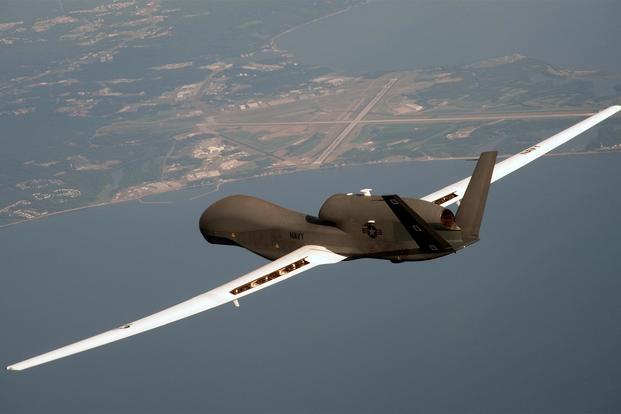U.S. intelligence, surveillance and reconnaissance flights haven't stopped or been scaled back since Iran shot down a Navy RQ-4 Global Hawk drone last week, according to the Air Force's top officer.
"Yes, we're continuing to fly," Chief of Staff Gen. David Goldfein said during a breakfast hosted by the Mitchell Institute in Washington, D.C. Wednesday. "We continue to fly where we need to, when we need to be there and as we do in all scenarios."
Goldfein continued, "this is a conversation we can have in the South China Sea, this is a conversation we can have anywhere in terms of international airspace in the global commons. We continue to protect those global commons [and] we continue to operate where we need to operate."
Iranian leaders said they refrained from shooting down a P-8 Poseidon surveillance aircraft flying in the region, and instead shot down the Global Hawk June 19, claiming the drone violated its airspace. U.S. Central Command officials said neither the RQ-4 nor P-8 entered Iranian airspace that day, but added that U.S. aircraft routinely operate in the region.
Related content:
- Air Force Seeks to Change How Drone Pilots Train, Fly
- Iran Says it Almost Downed a P-8 Surveillance Plane. Here's What the P-8 Does
- US Denounces 'Unprovoked Attack' After Iran Shoots Down High-Value Navy Drone
The RQ-4 was "operating at high altitude, approximately 34 kilometers [about 21 miles] from the nearest point of land on the Iranian coast," Lt. Gen. Joseph Guastella, commander of U.S. Air Forces Central Command, told reporters following the incident.
Goldfein added he has not seen a "significant change" in the capabilities of the Iranians.
The Iranians claimed to have used their 3rd Khordad launcher to down the drone. That surface-to-air missile system is a local variant of the Russian Buk M3, which shot down Malaysia Airlines flight MH17 over eastern Ukraine in 2014. However, U.S. military officials told Newsweek the system used was likely a shorter-range SA-3 Goa.
While it's not believed to have been used, Iran earlier this month showcased its new missile system, the Khordad 15th, presumed to have longer strike range. Iran also has Russian-made S-300 missile defense systems.
Goldfein said the Joint Chiefs continue to evaluate options for President Donald Trump as tensions persist between Iran and the U.S.
"My job as a joint chief is to ensure that we are presenting executable options for the commander-in-chief," he said. "And so we continue to do that, to make sure that the options that are presented are executable and that he understands the implications, and then of course the decision from our civilian leadership, whether to employ those options."
The New York Times first reported Trump had decided at the last minute to call back retaliation strikes on Iran after the drone shootdown. Unidentified senior U.S. officials told the newspaper Trump had first approved the strikes that would have targeted radar and missile battery sites, but then abruptly called it off.
Trump disputed the report.
"I never called the strike against Iran "BACK," as people are incorrectly reporting," he tweeted on June 22. "I just stopped it from going forward at this time!"
The drone incident comes at a time when the Pentagon is weighing whether it can use older technology in contested environments, especially if the equipment is not survivable.
Then-Secretary Heather Wilson last year made the case, alongside Goldfein, not to pursue future upgrades to the E-8C Joint Surveillance Target Attack Radar System, because it would be vulnerable in a high-end conflict.
Because of its capability to fly high, the Global Hawk has been seen as less vulnerable to such threats.
"This drone was specifically designed to be largely invulnerable -- because it flies so extremely high," Ulrike Esther Franke, a drone scholar and policy fellow with the European Council on Foreign Relations, said on Twitter last week.
The RQ-4 flies at upward of 60,000 feet.
-- Oriana Pawlyk can be reached at oriana.pawlyk@military.com. Follow her on Twitter at @oriana0214.















